
A sporangium, also known as a "sporange", is an enclosure in which spores are formed. It can be composed of a single cell or can be multicellular. Virtually all plants, fungi, and many other lineages form sporangia at some point in their life cycle. Sporangia can produce spores by mitosis, but in nearly all land plants and many fungi, sporangia are the site of meiosis and produce genetically distinct haploid spores.

The Marchantiophyta are a division of non-vascular land plants commonly referred to as hepatics or liverworts. Like mosses and hornworts, they have a gametophyte-dominant life cycle, in which cells of the plant carry only a single set of genetic information.
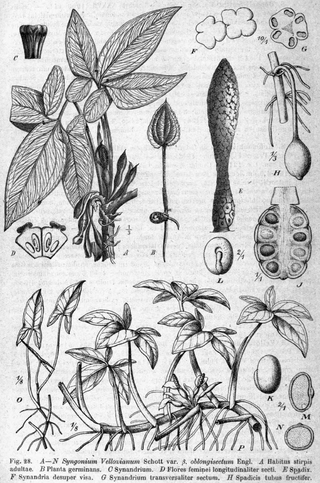
Syngonium is a genus of flowering plants in the family Araceae, native to tropical rainforests in southern Mexico, the West Indies, Central and South America. They are woody vines growing to heights of 10–20 m or more in trees. They have leaves that change shape according to the plant's stage of growth, and adult leaf forms are often much more lobed than the juvenile forms usually seen on small house plants. The scientific name of the genus comes from the Greek words σύν and γονή and refers to the fused ovaries of female flowers.

Psychotria viridis, also known as chacruna, chacrona, or chaqruy in the Quechua languages, is a perennial, shrubby flowering plant in the coffee family Rubiaceae. It is a close relative of Psychotria carthagenensis of Ecuador. It is commonly used as an ingredient of ayahuasca, a decoction with a long history of its entheogenic use and its status as a "plant teacher" among the Indigenous peoples of the Amazon rainforest.

A gemma is a single cell, or a mass of cells, or a modified bud of tissue, that detaches from the parent and develops into a new individual. This type of asexual reproduction is referred to as fragmentation. It is a means of asexual propagation in plants. These structures are commonly found in fungi, algae, liverworts and mosses, but also in some flowering plants such as pygmy sundews and some species of butterworts. Vascular plants have many other methods of asexual reproduction including bulbils and turions.
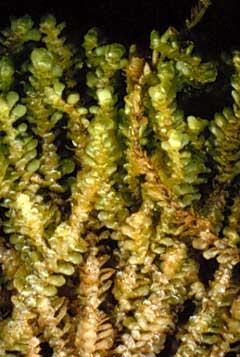
Jungermanniales is the largest order of liverworts. They are distinctive among the liverworts for having thin leaf-like flaps on either side of the stem. Most other liverworts are thalloid, with no leaves. Due to their dorsiventral organization and scale-like, overlapping leaves, the Jungermanniales are sometimes called "scale-mosses".

Lejeuneaceae is the largest family of liverworts. Most of its members are epiphytes found in the tropics, while others can be found in temperate regions.

Succubous is a manner in which the leaves of a liverwort overlap. If one were to look down from above on a plant where the leaf attachment is succubous, the upper edge of each leaf would be covered by the next leaf along the stem. The lower edge of each leaf is visible from above, but the edge of the leaf closer to the tip of the stem is obscured by a neighboring leaf. The opposite of succubous is incubous.

The epidermis is a single layer of cells that covers the leaves, flowers, roots and stems of plants. It forms a boundary between the plant and the external environment. The epidermis serves several functions: it protects against water loss, regulates gas exchange, secretes metabolic compounds, and absorbs water and mineral nutrients. The epidermis of most leaves shows dorsoventral anatomy: the upper (adaxial) and lower (abaxial) surfaces have somewhat different construction and may serve different functions. Woody stems and some other stem structures such as potato tubers produce a secondary covering called the periderm that replaces the epidermis as the protective covering.

Rumex longifolius, commonly known as the dooryard dock or northern dock, is a perennial species of plant in the genus Rumex.
This page provides a glossary of plant morphology. Botanists and other biologists who study plant morphology use a number of different terms to classify and identify plant organs and parts that can be observed using no more than a handheld magnifying lens. This page provides help in understanding the numerous other pages describing plants by their various taxa. The accompanying page—Plant morphology—provides an overview of the science of the external form of plants. There is also an alphabetical list: Glossary of botanical terms. In contrast, this page deals with botanical terms in a systematic manner, with some illustrations, and organized by plant anatomy and function in plant physiology.
This glossary of botanical terms is a list of definitions of terms and concepts relevant to botany and plants in general. Terms of plant morphology are included here as well as at the more specific Glossary of plant morphology and Glossary of leaf morphology. For other related terms, see Glossary of phytopathology, Glossary of lichen terms, and List of Latin and Greek words commonly used in systematic names.
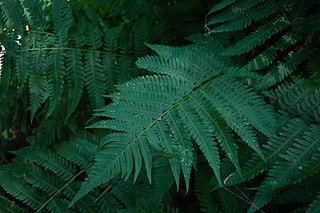
Dryopteris goldieana, commonly called Goldie's wood fern, or giant wood fern is a fern native to the eastern United States and adjacent areas of Canada, from New Brunswick to Ontario and Georgia. It is the largest native North American species of Dryopteris and along with ostrich fern it is one of the largest ferns in eastern North America. Specimens are known with fronds six feet tall. D. goldieana hybridizes with many other species of Dryopteris and the hybrids tend to be larger than the pure species. It was named by William Hooker in honor of its discoverer, John Goldie. The epithet was originally published as goldiana, but this is regarded as a misspelling to be corrected.
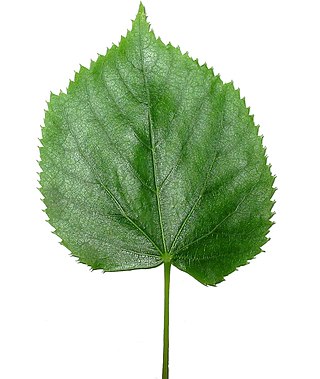
A leaf is a principal appendage of the stem of a vascular plant, usually borne laterally aboveground and specialized for photosynthesis. Leaves are collectively called foliage, as in "autumn foliage", while the leaves, stem, flower, and fruit collectively form the shoot system. In most leaves, the primary photosynthetic tissue is the palisade mesophyll and is located on the upper side of the blade or lamina of the leaf but in some species, including the mature foliage of Eucalyptus, palisade mesophyll is present on both sides and the leaves are said to be isobilateral. Most leaves are flattened and have distinct upper (adaxial) and lower (abaxial) surfaces that differ in color, hairiness, the number of stomata, the amount and structure of epicuticular wax and other features. Leaves are mostly green in color due to the presence of a compound called chlorophyll which is essential for photosynthesis as it absorbs light energy from the sun. A leaf with lighter-colored or white patches or edges is called a variegated leaf.

Ptilidium is a genus of liverwort, and is the only genus in family Ptilidiaceae. It includes only three species: Ptilidium californicum, Ptilidium ciliare, and Ptilidium pulcherrimum. The genus is distributed throughout the arctic and subarctic, with disjunct populations in New Zealand and Tierra del Fuego. Molecular analysis suggests that the genus has few close relatives and diverged from other leafy liverworts early in their evolution.

Lophocolea heterophylla, the variable-leaved crestwort, is a liverwort species belonging to the order Jungermanniales, which is the largest liverwort order.
Hypericum collinum is a flowering plant in the family Hypericaceae which is found in Mexico.

Asterella californica is a complex thallic liverwort in the phylum Marchantiophyta. A. californica often grows as colonies of flat rosettes of light green, rigid thalli, with undersides dark wine-red to nearly black. The receptacles are rounded, with four lobes each bearing a single sporangium sheathed by a white tattered skirt. A. californica is dioecious with separate male plants often intermingled with female plants. This species is found throughout California from San Francisco southward to San Diego and Guadalupe Island. Asterella californica is the commonest species of the three species of Asterella occurring in California; the other two species are A. bolanderi and A. palmeri.
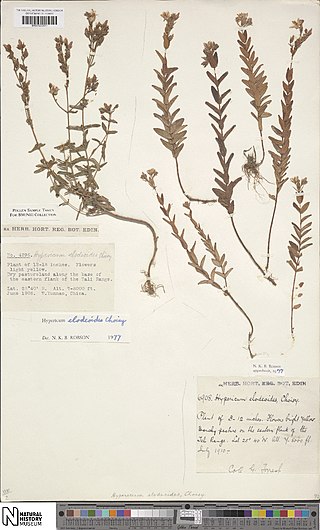
Hypericum elodeoides, commonly called the Himalayan St. John's Wort, is a species of flowering plant of the St. John's wort family (Hypericaceae).
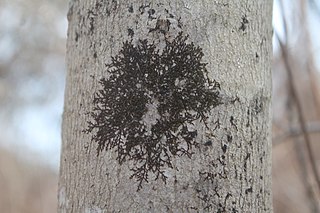
Frullania eboracensis, the New York scalewort, is a species of liverwort in the family Frullaniaceae. New York Scalewort can be distinguished from other species of scalewort by its morphology. In particular, the small size, lower leaf lobes that are about as long as they are across, lower leaf lobes that are about one-third to one-half the size of upper leaf lobes, underleaves that are only a little wider than their stems. The underleaves of New York Scalewort have toothless or nearly toothless lateral margins, and perianths that have smooth to slightly roughened keels along their sides. Despite some distinctive morphology, microscopy is often necessary to confidently distinguish New York Scalewort from other species of Frullania, and the cells of the leaves have diagnostic irregular, jagged edges and cell walls are swollen at intervals.

















